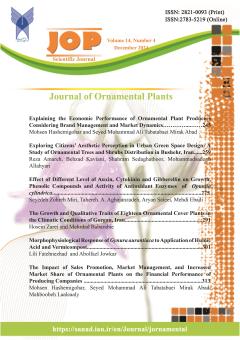پاسخ مورفوفیزیولوژیکی گیاه ژینورا (Gynura aurantiaca) به کاربرد اسید هیومیک و ورمی کمپوست
محورهای موضوعی : مجله گیاهان زینتیلی لی فاتح نژاد 1 , ابوالفضل جوکار 2
1 - گروه علوم باغبانی، دانشکده کشاورزی، دانشگاه شیراز. شیراز، ایران
2 - گروه اصلاح نباتات، پژوهشکده کشاورزی هسته ای، پژوهشگاه علوم و فنون هستهای (NSTRI)، سازمان انرژی اتمی ایران
کلید واژه: فعالیت آنزیم آنتیاکسیدانی, کود زیستی, میزان کلروفیل, کشاورزی پایدار,
چکیده مقاله :
این مطالعه به بررسی تأثیر اسید هیومیک و ورمیکمپوست به عنوان کودهای طبیعی خاک بر ویژگیهای مورفوفیزیولوژیکی گیاه Gynura aurantiaca میپردازد. برای تعیین تأثیر این مواد در دوزهای مختلف بر رشد و فعالیت آنزیم آنتیاکسیدانی ژینورا، از ورمیکمپوست (0، 2، 4 و 6 درصد) و اسید هیومیک (0، 0/25، 0/5، 1 گرم بر کیلوگرم) در خاک استفاده شد. خصوصیات مورفولوژیکی G.aurantiaca شامل طول ساقه، سطح برگ، قطر ساقه، قطر برگ، وزن ریشهها و اندام هوایی تازه و خشک و خصوصیات فیزیولوژیکی و بیوشیمیایی آن شامل میزان کلروفیل a، b و کل مواد جامد محلول و فعالیت آنزیمهای آنتیاکسیدانی مورد مطالعه قرار گرفت. آزمایش بهصورت فاکتوریل در قالب طرح کاملاً تصادفی با سه تکرار در گلخانه تحقیقاتی دانشگاه شیراز در سال 1398 انجام شد. گیاهان تیمار شده با اسید هیومیک 5/0 گرم بر کیلوگرم در ترکیب با ورمیکمپوست 6 درصد باعث افزایش وزن خشک ریشه شدند. 1 گرم در کیلوگرم اسید هیومیک به همراه 6 درصد ورمیکمپوست باعث افزایش سطح برگ، قطر ساقه، قطر برگ، ارتفاع بوته، وزن تر ریشه، وزن تر اندام هوایی، وزن خشک اندام هوایی و همچنین فعالیت آنزیمهای آنتیاکسیدانی پراکسیداز و کاتالاز شد. میزان کلروفیل a، b و کل بهبود یافته در گیاهان تیمار شده با 5/0 گرم بر کیلوگرم اسید هیومیک در ترکیب 4 درصد ورمیکمپوست مشاهده شد. این نتایج نشان میدهد که مصرف همزمان اسید هیومیک و ورمیکمپوست برای بهبود رشد گیاهان ژینورا قابل توصیه است.
This study investigated the effect of humic acid and vermicompost as natural soil fertilizers on morphophysiological characteristics in Gynura aurantiaca. To determine the effect of these substances at different doses on the growth and antioxidant enzyme activity of Gynura, vermicompst (0, 2, 4 and 6%) and humic acid (0, 0.25, 0.5 and 1 g/kg) were applied at soil applications. Morphological characteristics of G.aurantiaca including stem length, leaf area, stem diameter, leaf diameter, the weight of fresh and dry roots and shoots and its physiological and biochemical characteristics including the content of chlorophyll a, b and total, soluble solids, and antioxidant enzymes activity were studied. The experiment was conducted as a factorial experiment based on completely randomized design with three replications in the research greenhouse of Shiraz University in 2019. Treated plants with 0.5 g/kg humic acid in combination with 6% vermicompost increased the root dry weight. 1 g/kg humic acid in co-application with 6% vermicompost enhanced leaf area, stem diameter, leaf diameter, plant height, root fresh weight, shoot fresh weight and shoot dry weight as well as the antioxidant enzymes activity of POD and CAT. The improved chlorophyll a, b and total contents were observed in plants treated with 0.5 g/kg humic acid in combination 4 % vermicompost. These results indicate that co application of humic acid and vermicompost is a useful fertilizer to improve growth in Gynura plants.


